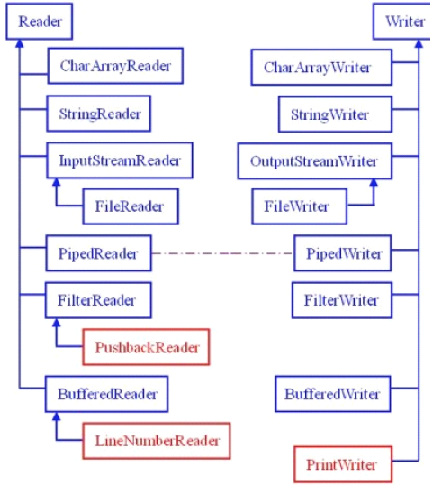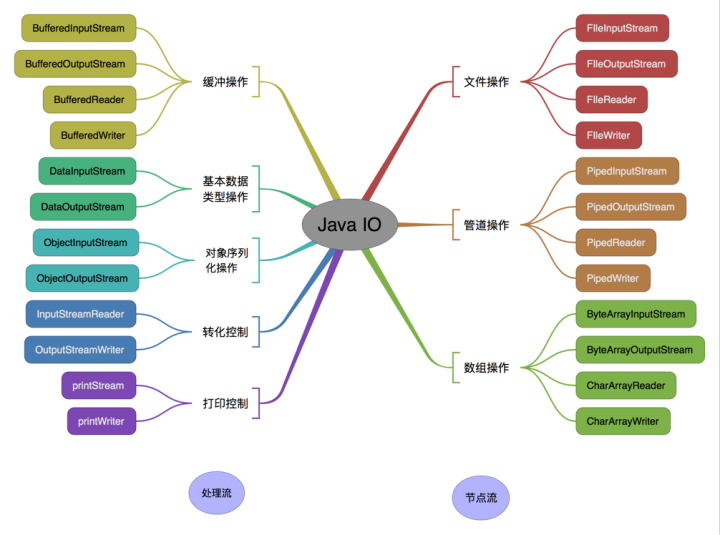这篇文章主要介绍“Java的IO流知识点有哪些”,在日常操作中,相信很多人在Java的IO流知识点有哪些问题上存在疑惑,小编查阅了各式资料,整理出简单好用的操作方法,希望对大家解答”Java的IO流知识点有哪些”的疑惑有所帮助!接下来,请跟着小编一起来学习吧!
字节流和字符流:
字节流:以字节为单位,每次次读入或读出是8位数据。可以读任何类型数据。
字符流:以字符为单位,每次次读入或读出是16位数据。其只能读取字符类型数据。
输出流和输入流:
输出流:从内存读出到文件。只能进行写操作。
输入流:从文件读入到内存。只能进行读操作。
注意:这里的出和入,都是相对于系统内存而言的。
节点流和处理流:
节点流:直接与数据源相连,读入或读出。
处理流:与节点流一块使用,在节点流的基础上,再套接一层,套接在节点流上的就是处理流。
为什么要有处理流?直接使用节点流,读写不方便,为了更快的读写文件,才有了处理流。
按操作方式分类结构图:
根据以上分类,以及jdk的说明,我们可以画出更详细的类结构图,如下:

分类说明
1. 输入字节流InputStream:
输入字节流的继承图可见上图,可以看出:
FileInputStream: 是三种基本的介质流,它们分别从Byte 数组、StringBuffer、和本地文件中读取数据。
ByteArrayInputStream:
PipedInputStream: 是从与其它线程共用的管道中读取数据。PipedInputStream的一个实例要和PipedOutputStream的一个实例共同使用,共同完成管道的读取写入操作。主要用于线程操作。
ObjectInputStream 和所有FilterInputStream 的子类都是装饰流(装饰器模式的主角)
2. 输出字节流OutputStream:
输出字节流的继承图可见上图,可以看出:
FIleOutputStream:是两种基本的介质流
ByteArrayOutputStream: 是两种基本的介质流,它们分别向Byte 数组、和本地文件中写入数据。
PipedOutputStream:是向与其它线程共用的管道中写入数据。
ObjectOutputStream 和所有FilterOutputStream 的子类都是装饰流。
字节流的输入和输出对照图:

3. 字符输入流Reader:
在上面的继承关系图中可以看出:
FileReader:
PipedReader:是从与其它线程共用的管道中读取数据
CharArrayReader:
CharReader、StringReader 是两种基本的介质流,它们分别将Char 数组、String中读取数据。
BufferedReader 很明显就是一个装饰器,它和其子类负责装饰其它Reader 对象。
FilterReader 是所有自定义具体装饰流的父类,其子类PushbackReader 对Reader 对象进行装饰,会增加一个行号。
InputStreamReader: 是一个连接字节流和字符流的桥梁,它将字节流转变为字符流。FileReader 可以说是一个达到此功能、常用的工具类,在其源代码中明显使用了将FileInputStream 转变为Reader 的方法。我们可以从这个类中得到一定的技巧。Reader 中各个类的用途和使用方法基本和InputStream 中的类使用一致。后面会有Reader 与InputStream 的对应关系。
4. 字符输出流Writer:
在上面的关系图中可以看出:
FileWriter:
PipedWriter:是向与其它线程共用的管道中写入数据
CharArrayWriter:
CharArrayWriter、StringWriter 是两种基本的介质流,它们分别向Char 数组、String 中写入数据。
BufferedWriter 是一个装饰器,为Writer 提供缓冲功能。
PrintWriter 和PrintStream 极其类似,功能和使用也非常相似。
OutputStreamWriter: 是OutputStream 到Writer 转换的桥梁,它的子类FileWriter 其实就是一个实现此功能的具体类(具体可以研究一SourceCode)。功能和使用和OutputStream 极其类似,后面会有它们的对应图。
字符流的输入和输出对照图:

5. 字符流与字节流转换
转换流的特点:
其是字符流和字节流之间的桥梁;
可对读取到的字节数据经过指定编码转换成字符;
可对读取到的字符数据经过指定编码转换成字节;
何时使用转换流?
当字节和字符之间有转换动作时;
流操作的数据需要编码或解码时。
具体的实现:
InputStreamReader:输入流转到读流;
String fileName= "d:"+File.separator+"hello.txt";
File file=new File(fileName);
Writer out=new OutputStreamWriter(new FileOutputStream(file));
out.write("hello");
out.close();OutputStreamWriter:输出流转到写流;
String fileName= "d:"+File.separator+"hello.txt"; File file=new File(fileName); Reader read=new InputStreamReader(new FileInputStream(file)); char[] b=new char[100]; int len=read.read(b); System.out.println(new String(b,0,len)); read.close();
这两个流对象是字符体系中的成员,它们有转换作用,本身又是字符流,所以在构造的时候需要传入字节流对象进来。
按操作对象分类结构图:

分类说明:
对文件进行操作(节点流):
FileInputStream(字节输入流),
FileOutputStream(字节输出流),
FileReader(字符输入流),
FileWriter(字符输出流)
对管道进行操作(节点流):
PipedInputStream(字节输入流),
PipedOutStream(字节输出流),
PipedReader(字符输入流),
PipedWriter(字符输出流)。
PipedInputStream的一个实例要和PipedOutputStream的一个实例共同使用,共同完成管道的读取写入操作。主要用于线程操作。
字节/字符数组流(节点流):
ByteArrayInputStream,
ByteArrayOutputStream,
CharArrayReader,
CharArrayWriter;
是在内存中开辟了一个字节或字符数组。
除了上述三种是节点流,其他都是处理流,需要跟节点流配合使用。
Buffered缓冲流(处理流):
BufferedInputStream,
BufferedOutputStream,
BufferedReader,
BufferedWriter,
是带缓冲区的处理流,缓冲区的作用的主要目的是:避免每次和硬盘打交道,提高数据访问的效率。
转化流(处理流):
InputStreamReader:把字节转化成字符;
OutputStreamWriter:把字节转化成字符。
基本类型数据流(处理流):用于操作基本数据类型值。
DataInputStream,
DataOutputStream。
因为平时若是我们输出一个8个字节的long类型或4个字节的float类型,那怎么办呢?可以一个字节一个字节输出,也可以把转换成字符串输出,但是这样转换费时间,若是直接输出该多好啊,因此这个数据流就解决了我们输出数据类型的困难。数据流可以直接输出float类型或long类型,提高了数据读写的效率。
打印流(处理流):
PrintStream,
PrintWriter,
一般是打印到控制台,可以进行控制打印的地方。
对象流(处理流):
ObjectInputStream,对象反序列化;
ObjectOutputStream,对象序列化;
把封装的对象直接输出,而不是一个个在转换成字符串再输出。
合并流(处理流):
SequenceInputStream:可以认为是一个工具类,将两个或者多个输入流当成一个输入流依次读取。
1. 复制文件:
/**
* 复制文件:一边读,一边写
*/
class hello {
public static void main(String[] args) throws IOException {
if (args.length != 2) {
System.out.println("命令行参数输入有误,请检查");
System.exit(1);
}
File file1 = new File(args[0]);
File file2 = new File(args[1]);
if (!file1.exists()) {
System.out.println("被复制的文件不存在");
System.exit(1);
}
InputStream input = new FileInputStream(file1);
OutputStream output = new FileOutputStream(file2);
if ((input != null) && (output != null)) {
int temp = 0;
while ((temp = input.read()) != (-1)) {
output.write(temp);
}
}
input.close();
output.close();
}
}说明:
流在使用结束后,一定要执行关闭操作,即调用close( )方法。
FileInputStream.read():
这个方法是对这个流一个一个字节的读,返回的结果就是这个字节的int表示方式;
当已经没有内容时,返回的结果为-1;
FileOutputStream.write():
将内容写到文件。
2. 不使用FIle,将流中的字符转换大写小:
public static void main(String[] args) throws IOException {
String str = "ROLLENHOLT";
ByteArrayInputStream input = new ByteArrayInputStream(str.getBytes());
ByteArrayOutputStream output = new ByteArrayOutputStream();
int temp = 0;
while ((temp = input.read()) != -1) {
char ch = (char) temp;
output.write(Character.toLowerCase(ch));
}
String outStr = output.toString();
input.close();
output.close();
System.out.println(outStr);
}说明:
流在使用结束后,一定要执行关闭操作,即调用close( )方法。
3. 使用管道流在多个线程间通信:
/**
* 消息发送类
* */
class Send implements Runnable {
private PipedOutputStream out = null;
public Send() {
out = new PipedOutputStream();
}
public PipedOutputStream getOut() {
return this.out;
}
public void run() {
String message = "hello , Rollen";
try {
out.write(message.getBytes());
} catch (Exception e) {
e.printStackTrace();
}
try {
out.close();
} catch (Exception e) {
e.printStackTrace();
}
}
}
/**
* 接受消息类
*/
class Recive implements Runnable {
private PipedInputStream input = null;
public Recive() {
this.input = new PipedInputStream();
}
public PipedInputStream getInput() {
return this.input;
}
public void run() {
byte[] b = new byte[1000];
int len = 0;
try {
len = this.input.read(b);
} catch (Exception e) {
e.printStackTrace();
}
try {
input.close();
} catch (Exception e) {
e.printStackTrace();
}
System.out.println("接受的内容为 " + (new String(b, 0, len)));
}
}
/**
* 测试类
*/
class hello {
public static void main(String[] args) throws IOException {
Send send = new Send();
Recive recive = new Recive();
try {
//管道连接
send.getOut().connect(recive.getInput());
} catch (Exception e) {
e.printStackTrace();
}
new Thread(send).start();
new Thread(recive).start();
}
}4. 使用缓冲区从键盘上读入内容:
public static void main(String[] args) throws IOException {
BufferedReader buf = new BufferedReader(
new InputStreamReader(System.in));
String str = null;
System.out.println("请输入内容");
try{
str = buf.readLine();
}catch(IOException e){
e.printStackTrace();
}
System.out.println("你输入的内容是:" + str);
}5. 将系统输出定向到文件:
public static void main(String[] args) throws IOException {
File file = new File("/Users/liuluming/Documents/hello.txt");
// 此刻直接输出到屏幕
System.out.println("hello");
try {
System.setOut(new PrintStream(new FileOutputStream(file)));
} catch (FileNotFoundException e) {
e.printStackTrace();
}
System.out.println("这些内容在文件中才能看到哦!");
}File类是对文件系统中文件以及文件夹进行封装的对象,可以通过对象的思想来操作文件和文件夹。 File类保存文件或目录的各种元数据信息,包括文件名、文件长度、最后修改时间、是否可读、获取当前文件的路径名,判断指定文件是否存在、获得当前目录中的文件列表,创建、删除文件和目录等方法。
该对象并不是流体系中的一员,其封装了字节流,同时还封装了一个缓冲区(字符数组),通过内部的指针来操作字符数组中的数据。 该对象特点:
该对象只能操作文件,所以构造函数接收两种类型的参数:a.字符串文件路径;b.File对象。
该对象既可以对文件进行读操作,也能进行写操作,在进行对象实例化时可指定操作模式(r,rw)。
注意:
该对象在实例化时,如果要操作的文件不存在,会自动创建;如果文件存在,写数据未指定位置,会从头开始写,即覆盖原有的内容。 可以用于多线程下载或多个线程同时写数据到文件
到此,关于“Java的IO流知识点有哪些”的学习就结束了,希望能够解决大家的疑惑。理论与实践的搭配能更好的帮助大家学习,快去试试吧!若想继续学习更多相关知识,请继续关注亿速云网站,小编会继续努力为大家带来更多实用的文章!
免责声明:本站发布的内容(图片、视频和文字)以原创、转载和分享为主,文章观点不代表本网站立场,如果涉及侵权请联系站长邮箱:is@yisu.com进行举报,并提供相关证据,一经查实,将立刻删除涉嫌侵权内容。